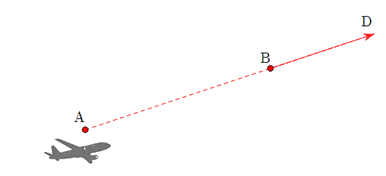Cho hình chóp \[S.ABCD\] có đáy \[ABCD\] là hình bình hành. Đặt \[\overrightarrow {SA} = \overrightarrow a \], \[\overrightarrow {SB} = \overrightarrow b \], \[\overrightarrow {SC} = \overrightarrow c \], \[\overrightarrow {SD} = \overrightarrow d .\] Khẳng định nào dưới đây là đúng?
\[\overrightarrow a + \overrightarrow c = \overrightarrow b + \overrightarrow d \].
\[\overrightarrow a + \overrightarrow b + \overrightarrow c + \overrightarrow d = \overrightarrow 0 \].
\[\overrightarrow a + \overrightarrow d = \overrightarrow b + \overrightarrow c \].
\[\overrightarrow a + \overrightarrow b = \overrightarrow c + \overrightarrow d \].
Câu hỏi trong đề: Bài tập ôn tập Toán 12 Cánh diều Chương 2 có đáp án !!
Quảng cáo
Trả lời:
Đáp án đúng: A

Gọi \[O\] là tâm hình bình hành \[ABCD\]\[ \Rightarrow \left\{ \begin{array}{l}\overrightarrow {SA} + \overrightarrow {SC} = 2\overrightarrow {SO} = \overrightarrow a + \overrightarrow c \\\overrightarrow {SB} + \overrightarrow {SD} = 2\overrightarrow {SO} = \overrightarrow b + \overrightarrow d \end{array} \right.\]\[ \Rightarrow \overrightarrow a + \overrightarrow c = \overrightarrow b + \overrightarrow d \].
Hot: 1000+ Đề thi cuối kì 1 file word cấu trúc mới 2025 Toán, Văn, Anh... lớp 1-12 (chỉ từ 60k). Tải ngay
- 20 Bộ đề, Tổng ôn, sổ tay môn Toán (có đáp án chi tiết) ( 55.000₫ )
- 20 đề thi tốt nghiệp môn Toán (có đáp án chi tiết) ( 38.500₫ )
- Sổ tay lớp 12 các môn Toán, Lí, Hóa, Văn, Sử, Địa, KTPL (chương trình mới) ( 36.000₫ )
- Bộ đề thi tốt nghiệp 2025 các môn Toán, Lí, Hóa, Văn, Anh, Sinh, Sử, Địa, KTPL (có đáp án chi tiết) ( 36.000₫ )
CÂU HỎI HOT CÙNG CHỦ ĐỀ
Câu 1
\(\alpha = 90^\circ \).
\(\alpha = 180^\circ \).
\(\alpha = 60^\circ \).
\(\alpha = 45^\circ \).
Lời giải
Đáp án đúng: B
Ta có \(\vec u \bot \vec v \Rightarrow \vec u.\vec v = 0 \Leftrightarrow \left( {\frac{2}{5}\overrightarrow a - 3\overrightarrow b } \right)\left( {\overrightarrow a + \overrightarrow b } \right) = 0 \Leftrightarrow \frac{2}{5}{\overrightarrow a ^2} - \frac{{13}}{5}\overrightarrow a \overrightarrow b - 3{\overrightarrow b ^2} = 0\).
Suy ra \(cos\left( {\overrightarrow a ,\overrightarrow b } \right) = \frac{{\vec a.\overrightarrow b }}{{\left| {\vec a} \right|.\left| {\overrightarrow b } \right|}} = - 1 \Rightarrow \left( {\overrightarrow a ,\overrightarrow b } \right) = 180^\circ \).
Lời giải
a) Đúng. Theo công thức vì \[G\] là trọng tâm tứ diện \[ABCD \Rightarrow \overrightarrow {GA} + \overrightarrow {GB} + \overrightarrow {GC} + \overrightarrow {GD} = \overrightarrow 0 \].
b) Đúng. Ta có:
\[\overrightarrow {OG} = \frac{1}{4}\left( {\overrightarrow {OG} + \overrightarrow {OG} + \overrightarrow {OG} + \overrightarrow {OG} } \right) = \frac{1}{4}\left( {\overrightarrow {OA} + \overrightarrow {AG} + \overrightarrow {OB} + \overrightarrow {BG} + \overrightarrow {OC} + \overrightarrow {CG} + \overrightarrow {OD} + \overrightarrow {DG} } \right)\]\[ = \frac{1}{4}\left( {\overrightarrow {OA} + \overrightarrow {OB} + \overrightarrow {OC} + \overrightarrow {OD} } \right)\].
c) Đúng.\[\overrightarrow {GA} + \overrightarrow {GB} + \overrightarrow {GC} + \overrightarrow {GD} = \overrightarrow 0 \Leftrightarrow \overrightarrow {GA} + \overrightarrow {GC} + \overrightarrow {GD} = - \overrightarrow {GB} = \overrightarrow {BG} \].
d) Sai.\[\overrightarrow {AG} = \overrightarrow {AO} + \overrightarrow {OG} = \overrightarrow {AO} + \frac{1}{4}\left( {\overrightarrow {OA} + \overrightarrow {OB} + \overrightarrow {OC} + \overrightarrow {OD} } \right) = \overrightarrow {AO} + \frac{1}{4}\left( {4\overrightarrow {OA} + \overrightarrow {AB} + \overrightarrow {AC} + \overrightarrow {AD} } \right)\]
\[ = \overrightarrow {AO} + \overrightarrow {OA} + \frac{1}{4}\left( {\overrightarrow {AB} + \overrightarrow {AC} + \overrightarrow {AD} } \right) = \frac{1}{4}\left( {\overrightarrow {AB} + \overrightarrow {AC} + \overrightarrow {AD} } \right)\].
Lời giải
Bạn cần đăng ký gói VIP ( giá chỉ từ 199K ) để làm bài, xem đáp án và lời giải chi tiết không giới hạn.
Lời giải
Bạn cần đăng ký gói VIP ( giá chỉ từ 199K ) để làm bài, xem đáp án và lời giải chi tiết không giới hạn.
Lời giải
Bạn cần đăng ký gói VIP ( giá chỉ từ 199K ) để làm bài, xem đáp án và lời giải chi tiết không giới hạn.
Lời giải
Bạn cần đăng ký gói VIP ( giá chỉ từ 199K ) để làm bài, xem đáp án và lời giải chi tiết không giới hạn.
Câu 7
\[\overrightarrow {DM} = \frac{1}{2}\left( {\overrightarrow a + \overrightarrow b - 2\overrightarrow c } \right)\].
\[\overrightarrow {DM} = \frac{1}{2}\left( {\overrightarrow a + 2\overrightarrow b - \overrightarrow c } \right)\].
\[\overrightarrow {DM} = \frac{1}{2}\left( {\overrightarrow a - 2\overrightarrow b + \overrightarrow c } \right)\].
\[\overrightarrow {DM} = \frac{1}{2}\left( {\overrightarrow a + 2\overrightarrow b - \overrightarrow c } \right)\].
Lời giải
Bạn cần đăng ký gói VIP ( giá chỉ từ 199K ) để làm bài, xem đáp án và lời giải chi tiết không giới hạn.


